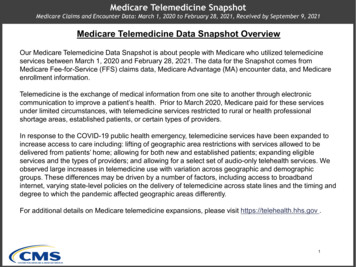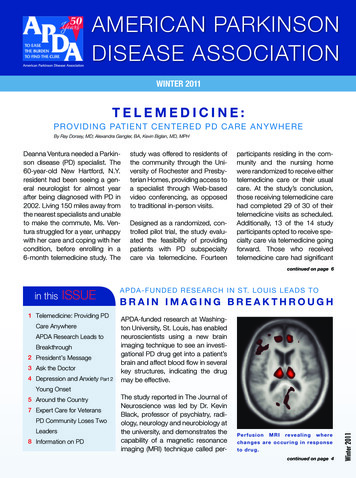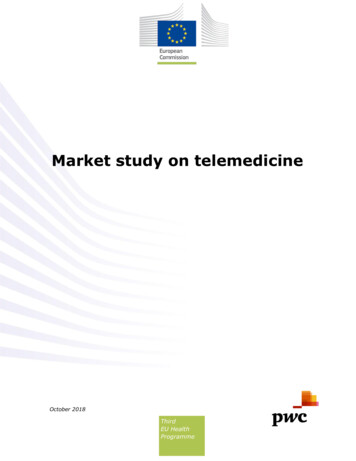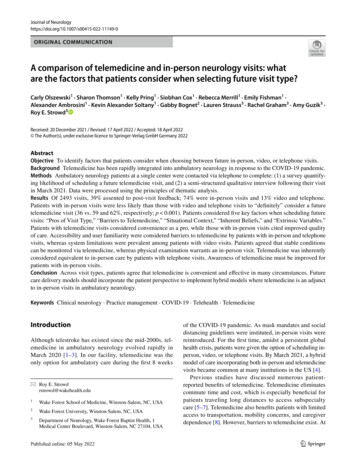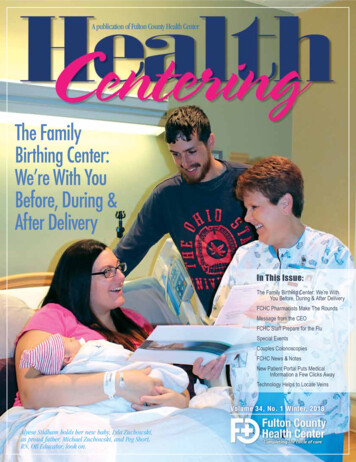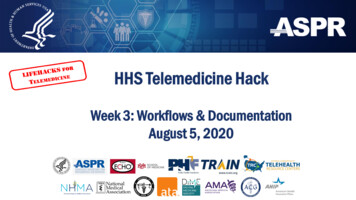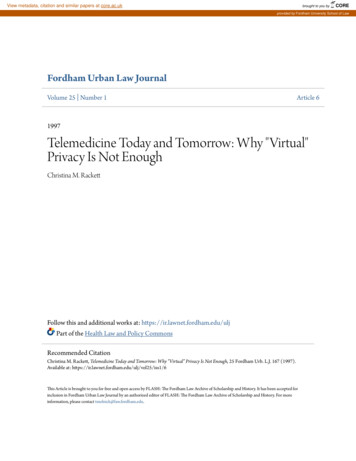
Transcription
View metadata, citation and similar papers at core.ac.ukbrought to you byCOREprovided by Fordham University School of LawFordham Urban Law JournalVolume 25 Number 1Article 61997Telemedicine Today and Tomorrow: Why "Virtual"Privacy Is Not EnoughChristina M. RackettFollow this and additional works at: https://ir.lawnet.fordham.edu/uljPart of the Health Law and Policy CommonsRecommended CitationChristina M. Rackett, Telemedicine Today and Tomorrow: Why "Virtual" Privacy Is Not Enough, 25 Fordham Urb. L.J. 167 (1997).Available at: https://ir.lawnet.fordham.edu/ulj/vol25/iss1/6This Article is brought to you for free and open access by FLASH: The Fordham Law Archive of Scholarship and History. It has been accepted forinclusion in Fordham Urban Law Journal by an authorized editor of FLASH: The Fordham Law Archive of Scholarship and History. For moreinformation, please contact tmelnick@law.fordham.edu.
Telemedicine Today and Tomorrow: Why "Virtual" Privacy Is NotEnoughCover Page FootnoteJ.D. Candidate, Fordham University, 1998; B.A., summa cum laude, New York University, 1995. The authorthanks John, Trudy, and Kimberly Rackett for their tireless support and encouragement, and Jaie Solis for hisinfinite patience.This article is available in Fordham Urban Law Journal: https://ir.lawnet.fordham.edu/ulj/vol25/iss1/6
TELEMEDICINE TODAY AND TOMORROW:WHY "VIRTUAL" PRIVACY IS NOT ENOUGHChristina M. Rackett*IntroductionToday's telemedicine technology may conjure up thoughts of science fiction fantasies,' but it has existed since the 1950s.2Telemedicine, or "remote electronic clinical consultation, '3 permitspatients and doctors in different locations to communicate witheach other for diagnostic or educational purposes. Communicationis accomplished through the use of everyday means, such as telephones and fax machines, 4 as well as more sophisticated tools, including electronic stethoscopes, high resolution cameras, 5interactive television or computer lines,6 and satellites.7Telemedicine benefits patients in underserved,8 remote areas 9 byincreasing access to quality and specialized medical care. For exJ.D. Candidate, Fordham University, 1998; B.A., summa cum laude, New YorkUniversity, 1995. The author thanks John, Trudy, and Kimberly Rackett for theirtireless support and encouragement, and Jaie Solis for his infinite patience.1. For example, telemedicine can enable a doctor in one location to direct roboticequipment to perform surgery on a patient in another location. See Marilyn Hanzal,Telemedicine: 'Beam Me Up, Doctor', CHI. DAILY L. BULL., May 20, 1996, at 5.2. See Douglas D. Bradham et al., The Information Superhighway andTelemedicine: Applications, Status, and Issues, 30 WAKE FOREST L. REV. 145, 149(1995). The first telemedicine project was an interactive audio system which linkedseven hospitals in Nebraska, Iowa, North Dakota, and South Dakota for weeklymental health lectures. See id.3. Telemedicine Research Center, What Is Telemedicine (visited Sept. 26, 1996) http://tie.telemed.org .4. See Phyllis F. Granade & Jay H. Sanders, Implementing Telemedicine Nationwide: Analyzing the Legal Issues, 63 DEF. CouNs. J. 67, 67 (1996).5. See id.6. See Tony Cappasso, Telemedicine: The Latest Technology Is Bringing Doctorsand Far-Away Patients Closer Together, ST. J.-REG. (Springfield, I11.), Aug. 4, 1996, at15.7. See Telemedicine Research Center, supra note 3.8. For a discussion of why there is a shortage of physicians in rural areas, seegenerally Daniel McCarthy, Note, The Virtual Health Economy: Telemedicine and theSupply of Primary Care Physicians in Rural America, 21 AM. J.L. & MED. 111 (1995).9. These locations include primarily rural and inner city areas, which often lacksufficient available medical care; prisons and mental health institutions, where transporting sick patients to outside doctors requires extra staff and brings security risks;and nursing and private homes, where patients may not be able to travel to doctorsunaided. See Elizabeth Neus, Telemedicine Hailed as Future Wave of Industry ButDetractors Claim BarriersDoom Idea, Hous. POST, Mar. 19, 1995, at A5.*
168FORDHAM URBAN LAW JOURNAL[Vol. XXVample, a general practitioner in a rural town can link viatelemedicine to a cancer specialist at a prestigious urban medicalcenter for immediate advice on how to most effectively treat a patient. The use of telemedicine to share medical expertise and cutting-edge procedures has already saved lives.'"Telemedicine also decreases the cost of medical care to isolatedpatients" by reducing patients' and physicians' transportationcosts,' 2 and by limiting needless tests and duplication of records.13In addition, telemedicine's ease in delivering speedy care allowsbefore symptoms worsen, andphysicians to treat remote patients14before huge medical bills amass.Telemedicine's benefits,' 5 however, are hampered by unresolvedpatient privacy issues. Because of the easy access, duplication,and linkage capabilities of telemedicine technology, confidential10. A doctor in an urban hospital recently directed a rural doctor through his firstamputation surgery via video, thereby saving the patient's life. See Telemedicine Research Center, supra note 3. In addition, at least six lives have been saved in Texasdue to telemedicine. See Sharon Mcllrath, The Bottom Line (Telemedicine, Part4), 38No. 17 AM. MED. NEWS, May 1, 1995, available in 1995 WL 10008741. See also Spencer Rich, Battlefield Medicine Turns Electronic, WASH. POST, Oct. 18, 1996, at A25(discussing a United States Army estimate that one-third of American casualties during the Vietnam War could have been saved if there had been an advancedtelemedicine program in place).11. One study estimates that 80 billion spent on American health care could besaved annually by using telemedicine. See Jim Barlow, Telemedicine Faces Struggle,Hous. CHRON., Apr. 30, 1995, at 1. In addition, American hospitals currently save 14to 22 percent per year due to videoconferencing. See Marcia H. Pounds, Future IsNow for Videoconferencing, SUN-SENTINEL (Ft. Lauderdale, Fla.), Aug. 23, 1996, at1F.12. Because telemedicine enables medical services to be rendered without travel,it reduces instances of lost wages and lost time. See McIlrath, supra note 10; see alsoTelemedicine Research Center, supra note 3. Patients need not compensate doctorsfor "windshield time" spent commuting to a small town to deliver services. SeeMcllrath, supra note 10.13. See Neus, supra note 9, at A5.14. See Kathleen M. Vyborny, Legal and Political Issues Facing Telemedicine, 5ANNALS HEALTH L. 61, 63 (1996).15. Other benefits of telemedicine are educational and legal. For example, a doctor in a Texas hospital was prevented from delivering babies because the nurses' neonatal credentials had expired. The nurses then participated in telemedicine videotraining, received the required credentials, and were able to assist the doctor in 15deliveries in nine months. See Mc lrath, supra note 10. In addition, telemedicine maylessen medical malpractice liability by enabling doctors to quickly tap important information regarding a patient's condition and medical history, thus resulting in moreaccurate diagnoses. See Rodd Zolkos, Telemedicine Calls Liability Risks Into Ques-tion, Bus. INS., Oct. 21, 1996, at 3.16. For an outline of other legal problems surrounding telemedicine, including licensing and medical malpractice issues, see Robin E. Margolis, Law and Policy Barriers Hamper Growth of Telemedicine, 11 No. 10 HEALTHSPAN 14, 15 (1994).
TELEMEDICINE19971169patient data may be intercepted and misused by non-medical insiders, such as billing clerks and insurers, as well as outside hackers. 17As a result, particularly vulnerable patients, such as those withAIDS or mental illness, may be denied jobs, credit, insurance, s oreven their dignity.' 9 Telemedicine patients are not adequately protected against such invasions of privacy because states' medicalconfidentiality requirements are not uniform. 20 As a result, patients are subjected to varying levels of protection depending uponwhere they live 2 ' or where their doctor is licensed.This Note demonstrates the need for federal telemedicine legislation that provides uniform confidentiality protection for alltelemedicine patients. Part I details the use of telemedicine andoutlines the link between telemedicine and privacy issues. Part IIdiscusses current federal and state privacy law, emphasizing thelaws that protect medical information. Part III argues that federaltelemedicine legislation is necessary to safeguard the confidentiality of patients' medical records and proposes a uniform law thatprotects the privacy of telemedicine patients in every state. ThisNote concludes that without federal legislation, telemedicine willwither, along with isolated patients' hopes of one day receivingquality and affordable medical care.I. Telemedicine's Rise and Impact on Patient PrivacyForty years ago, when telemedicine was experimental, doctorsconferred with each other by telephone.22 Today, medical data,comprised of both text and images, can speed across state lines inseconds. Although this improved technology delivers muchneeded medical care to remote patients in inner cities and ruralareas, there are also negative by-products. More people than evercan access patients' personal health information electronically, including those who should not be privy to such information, such as17. See infra notes 53-60 and accompanying text.18. See infra notes 65-68 and accompanying text.19. See infra notes 61 and 73 and accompanying text (describing victims humiliated by the unauthorized disclosure of their personal health information).20. See Lawrence 0. Gostin et al., Privacy and Security of Health Information inthe Emerging Health Care System, 5 HEALTH MATRIX 1, 13 (1995) ("State privacylaws do exist, but they are not uniform . ").21. In California and New York, for example, doctors are prohibited from disclosing the names of HIV-positive patients' sexual partners to the state, while in Coloradoand Minnesota, such disclosure is mandatory. See Barry B. Cepelewicz, Telemedicine:A Virtual Reality, But Many Issues Need Resolving, 13 No. 9 MED. MALPRACTICE L.&STRATEGY1, 3 (1996).22. See Bradham, supra note 2, at 149.
170FORDHAM URBAN LAW JOURNAL[Vol. XXVunauthorized "curiosity seekers" 3 and clever hackers.2 4 Such unauthorized access can have disastrous personal and professionalconsequences on victimized patients.25A.The Development of TelemedicineTelemedicine's beginning in the 1950s was slow, but steady.26Doctors progressed from case consultation via audio equipment foreducational purposes2 7 to communicating with patients via closedcircuit telephone systems 28 and closed-circuit televisions. 29 Majordevelopments in early telemedicine were made by the NationalAeronautics and Space Administration (NASA). 3 23. A recent survey of health care professionals by the Healthcare Informationand Management Systems Society found that "[flour of 10 respondents identified internal curiosity seekers' as the No. 1 [security risk], while only 17% identified externalbreech [sic] of security by compuier hackers [as a concern] . . . ." John McCormack,Conference Survey Confirms Internet, Intranets Are Red Hot, HEALTH DATA MGMT.,Mar. 19, 1997, available in 1997 WL 8747811.24. See infra note 60.25. See infra notes 65-68.26. See Leslie G. Berkowitz, Is There a Doctor in the House?, 25-JUN COLO. LAw.19, 19 (1996) ("After a slow evolution using the telephone and fax machines, we arenow moving to distance education and remote electronic clinical consultation.").27. See Bradham, supra note 2, at 149 (describing weekly teleconferencing lectures linking seven hospitals in four different states).28. By 1961, psychiatrists were conducting group "telepsychiatry consultation[s]"with distant patients via telephone. See id.29. See Cappasso, supra note 6, at 15. For example, in 1967, employees and travelers at Logan International Airport received medical treatment from doctors at Massachusetts General Hospital via two-way audiovisual microwave equipment. SeeTelemedicine Research Center, History of Telemedicine (visited Sept. 26, 1996) http://tie.telemed.org .30. See Telemedicine Research Center, supra note 29. Beginning in the 1960s,while missions were in progress, the agency "telemetered" physiological readingsfrom both the spacecraft and the astronauts' space suits. See id. NASA later sharedits advances in satellite technology in experimental telemedicine programs in remoteareas of Arizona and Alaska. See id. The 1972-1975 Arizona program, Space Technology Applied to Rural Papago Advanced Health Care [STARPAHC], consisted ofa paramedic van supplied with microwave and audio transmission equipment whichlinked Indian patients on the Papago Reservation to specialists in distant hospitals.And in Alaska in 1971, NASA's first Applied Technology Satellite was used to bringhealth care to patients in 26 remotes sites via video consultation. See id. In addition,NASA has lent its expertise to several disaster relief efforts abroad. The SpaceBridge to Armenia program was launched in 1989 to bring United States specialists toearthquake victims in Armenia via telemedicine. The project was later expanded toprovide treatment for burn victims after a massive railway accident in Ufa, Russia.See id.
19971TELEMEDICINEToday, telemedicine has gained widespread support and use.3 'The federal government and thirteen states spent a combined 100million on telemedicine projects in the 1980s.32 During a single period between 1994 and 1995, federal and state contributions totelemedicine and similar advancements were estimated to reachmore than 100 million.33 Sixty percent of all telemedicine projectsin this country's hospitals have been developed within the past twoyears, 34 and twenty-nine percent of rural hospitals were predictedto use telemedicine by the end of 1996. 35Recently, the Department of Health and Human Services, in anattempt to increase isolated, underserved patients' access to qualityand affordable medical care, announced a decision to spend 42million in developing 19 telemedicine projects in 13 states. 36 In addition, the National Library of Medicine awarded Washington'sBeth Israel Deaconess Medical Center a 2.8 million contract 37 tostudy issues in telemedicine and other communication technologies. President Clinton signed the Health Centers ConsolidationAct in late 1996,38 which will award 36 million in grants to ruraltelemedicine developers in 1997 and perhaps more through 2001.Interstate and even international telemedicine projects are flourishing. For example, doctors in Minnesota, Florida, and Arizonaare linked via the Mayo Clinic's satellites for consultation purposes. 39 The Caribbean 4 and Bosnia 41 represent two sites 42 of in31. One commentator credits improved technology for the boon. See McCarthy,supra note 8, at 115 ("The resurgence of telemedicine has become possible only because of recent developments in technology . [T]he new systems are smaller, lessexpensive, and are of increased quality.") (citation omitted).32. See Ray Dussault, Telemedicine Poses Regulatory Woe, Bus. J.-SACRAMENTO,Apr. 22, 1996, at 21 (citing a 1995 American Medical Association report). The privatesector is spending millions on telemedicine as well. See id.33. See Berkowitz, supra note 26, at 19.34. See Telemedicine Programs Spreading Like Wildfire: But Is It Premature toEmbrace the New Technology?, BACK LETTER, May 1, 1996, at 54.35. See id. (referring to an Office of Rural Health Care Policy study).36. See Telemedicine Demonstration Project for Medicare Gets HHS Funding,MED. UTILIZATION MGMT., Oct. 17, 1996, available in 1996 WL 10524253.37. See -Lane Cooper, Telemedicine Market in Embryonic Stage, WASH. TECH.,Oct. 24, 1996, available in 1996 WL 11557362. The money will be used to develop"telemedicine computer home stations," in which parents at home can watch theirsick infants eat and sleep in the hospital's neonatal intensive care unit. Id. In addition, when the infants finally leave the hospital, they can still be observed by thedoctors via these monitors. Id.38. 42 U.S.C. § 254c (1997).39. See Ira Breskin, Telemedicine Gains Ground, But Hurdles To Use Remain, INVESTOR'S Bus. DAILY, Oct. 10, 1995, at A8.40. See Telemedicine Research Center, What's New (visited Sept. 26, 1996) http://tie.telemed.org . Massachusetts General Hospital and the Howard University Col-
172FORDHAM URBAN LAW JOURNAL[Vol. XXVternational telemedicine programs that bring quality care toremote patients.In response to the telemedical boom, groups such as the Centerfor Telemedicine Law,43 the Telemedicine Research Center,4 andthe Congressional Ad Hoc Steering Committee on. Telemedicineand Health Information 45 were established to further46telemedicine's development and to study privacy and other issuesarising from the new technology. In addition, numerous web sitesdevoted to telemedicine issues can be found on the Internet.47Commentators in the healthcare and telecommunications industries expect telemedicine to continue to flourish,48 making remoteconsultation "commonplace" in fields that rely on images, such asradiology, pathology, and ultrasound. 49 Video consultation is prelege of Medicine are cutting patient travel costs and inconvenience while simultaneously providing specialist care to the Caribbean. Id.41. See Cooper, supra note 37. A United States Army station in Maryland is usingtelemedicine to observe the troops' health overseas. Id.42. For a detailed account of current telemedicine programs nationwide, seeBradham, supra note 2, at 152-59.43. Telemedicine News: The Quest for Answers to Difficult Legal Questions, AUTOMATED MED. PAYMENTS NEWS, Dec. 6, 1995, available in 1995 WL 2281351. TheCenter, founded in 1995 by the Cleveland Clinic Foundation, the Mayo Foundation,the Midwest Rural Telemedicine Consortium, and Texas Children's Hospital, studieslegal issues that affect telemedicine. Id.44. See Telemedicine Research Center, About the TRC (visited Sept. 26, 1996) http://tie.telemed.org . The Center is a non-profit organization founded in 1994 tofurther the development of telemedicine. Id.45. The Committee was formed to tackle telemedicine issues at the federal level.See Implementation of Telecommunication Reforms a Boon to Health Care Providers,GoV'T PRESS RELEASES, Jun. 12, 1996, available in 1996 WL 8788123.46. The Center for Telemedicine Law, for example, is focusing on licensing andreimbursement questions. See AUTOMATED MED. PAYMENTS NEWS, supra note 43.47. See, e.g., http://tie.telemed.org (sponsored by the Telemedicine ResearchCenter), http://www.arentfox.com/telemedicine.html (sponsored by the Washington, D.C. law firm of Arent Fox Kintner Plotkin & Kahn), http://www.fcc.gov/Reports/telemed.txt (sponsored by the government), and http://www.telemedmag.com (providing on-line TELEMEDICINE AND TELEHEALTH NETWORKS magazine).48. See, e.g., Telemedicine: Fad or Future?, LANCET, Jan. 14, 1995, at 73. "Conservative" projections of the sales of telemedicine and similar equipment, amountingto just 77 million in 1995, are estimated to approach 100 billion in five years. SeeCooper, supra note 37. In addition, research and development continues to moveforward. For example, the Pentagon is developing "battlefield telemedicine" for thefuture. See Rich, supra note 10, at A25. The plan includes helmet-mounted camerasto be worn by medics on the scene, which would transmit images of the injured backto doctors in a distant location. Also in the works are personnel status monitors, to beworn by all soldiers, which would transmit any changes in vital signs, as well as positions on the battlefield, to distant medics and doctors. Id.49. See LANCET, supra note 48, at 73.
19971TELEMEDICINEdicted to reach more remote areas in the future, such as Antarcticaand space stations.5 B. The Link Between Telemedicine and PrivacyTelemedicine's risks to patient confidentiality and security ofmedical information stem from its reliance on computer technology to store, transmit, and retrieve medical records and images.Modern technology permits downloaded information to be accessed, copied, and even forwarded elsewhere with just a fewstrokes on a computer keyboard. 51 Currently, an estimated 80 people view a patient's health information during a patient's singlerendezvous with the health care system.52 These individuals mayinclude not only medical personnel, but hospital administrators, insurers, researchers, employers, and law enforcement officers.5 3Even though some of these individuals are authorized to access patients' confidential health information, they may fail to guard itproperly.54 In addition, the physicians' obligations of confidentiality in the Hippocratic Oath 55 and the American Medical Associa-50. See id.51. See, e.g., Community Health Management Information Systems ResourceCenter, Health Information Systems and Privacy (visited Sept. 26, 1996) http://chmis.org/ ("In an electronic environment., unique risks are present from simultaneous access to information from remote areas of the country, ease of duplication andtransfer, and the ability to more easily link various systems of records.").52. See id. These individuals may include not only health care personnel like doctors and nurses, but also hospital administrators and insurance companies.53. See Hearings on Medical Records Confidentiality Before the Subcomm. onGov't Management Information and Technology of the House Comm. on GovernmentReform and Oversight, 104th Cong. (June 14, 1996) (statement of Janlori Goldman,Deputy Director of the Center for Democracy and Technology), availablein 1996 WL10164954 ("Information demands of insurance companies, managed health care companies, researchers, employers and law enforcement are eroding the doctor-patientconfidentiality that is central to health care.") [hereinafter Hearings].54. See Robert Landauer, Histories That Hurt, PORTLAND OREGONIAN, Dec. 17,1996, at D09 ("[Doctors' and hospitals'] offices are awash in untrained personnel whodon't understand how to screen out information that should not be released.").55. The part of the oath referring to the physician's duty of confidentiality states:"And whatsoever I shall see or hear in the course of my profession, as well as outsidemy profession in my intercourse with men, if it be what should not be publishedabroad, I will never divulge, holding such things to be holy secret." Robert M. Gellman, Prescribing Privacy: The Uncertain Role of the Physician in the Protection ofPatient Privacy, 62 N.C. L. REV. 255, 267 (1984) (citing 1 HIPPOCRATES 164-65 (W.Jones trans., 1923), reprinted in ETHICS IN MEDICINE 5 (S. Reiser, A. Dyck & W.Curran eds., 1977)).
FORDHAM URBAN LAW JOURNAL[Vol. XXVtion's Code of Medical Ethics do not bind these non-medicalpersonnel.56Telemedicine's broad access capabilities could increase thenumber of individuals who are privy to patients' electronicallytransmitted medical records, 57 sparking new fears that the information may be intercepted and misused with even greater ease.58Current safeguards do not provide adequate protection. 59 Hackers, both clever outsiders as well as disgruntled insiders, can breakinto systems and obtain confidential information.6" Numerouscases of misuse of personal health information have been documented. For example, a New York Congresswoman had her medical records, including information about her depression and asuicide attempt, faxed to the media in the midst of her politicalcampaign.61 In Colorado, a medical student sold patients' confi56. The 1992 Code states: "The physician should not reveal confidential communiBernardcations or information without the express consent of the patient .Friedland, Time to Re-Examine a Venerable Concept in Light of Contemporary Societyand Advances in Medicine, 15 J. LEGAL MED. 249, 257 (1994) (citing AM. MED. Ass'N,CURRENT OPINIONS OF THE COUNCIL ON ETHICAL AND JUDICIAL AFFAIRS,No. 5.05(1992)).57. See James Rosenblum, Medical Liability in Cyberspace, 8 HEALTH LAW. 10, 10(1995) ("If physician[s'] offices are linked to local hospitals . nurses, billing clerks,data processing clerks, etc.[,] will have easy access to extensive amounts of medicalinformation.").58. See Diane M. Gianelli, Physician Input on Pressing Ethical Issues, AM. MED.July 22, 1996, at 3; see also Ilene K. Gotts & Alan D. Rutenberg, NavigatingtheGlobal Information Superhighway:A Bumpy Road Lies Ahead, 8 HARV. J.L. & TECH.275, 332 (1995) (citing National Research Council, Computers at Risk: Safe Computing in the Information Age (1991)) ("We are at risk. Increasingly, America dependson computers . The modern thief can steal more with a computer than with a gun.Tomorrow's terrorist may be able to do more damage with a keyboard than with abomb."); Paul M. Schwartz, The Protection of Privacy in Health Care Reform, 48VAND. L. REV. 295, 310 (1995) ("[T]he 'threats and personal harm' from disclosure ofhealth records 'are real and not numerically trivial.") (citation omitted).59. Current safeguards, such as passwords and access codes, are flawed in thatthey are inconvenient and not one hundred percent effective. See Hanzal, supra note1, at 5.60. For example, the Pentagon was the victim of 160,000 security breaches of itscomputer files in 1995. See Diane M. Gianelli, supra note 58, at 3; see also Terri F.Arnold, Note, Let Technology Counteract Technology: Protectingthe Medical Recordin the Computer Age, 15 HASTINGS COMM. & Errr. L.J. 455, 464 (1993) (describingnumerous abuses including the disclosure of a woman's AIDS diagnosis to her fellowemployees via information on the hospital computer); Sonya Savkar & Robert J. Waters, Telemedicine-Implicationsfor Patient Confidentialityand Privacy (visited Aug.27, 1996) http://www.arentfox.com.telemedicine.html (discussing a 1988 breach ofNEWS,an Arizona hospital's computer system by outsiders, and detailing the crimes of infa-mous hackers Kevin D. Mitnick and Mark Abene).61. See Hearings, supra note 53.
TELEMEDICINE19971dential medical records to malpractice attorneys. 62 And the personal problems of some employees who enlisted the aid ofemployee assistance programs were publicized throughout theworkplace.63Hackers have a large incentive to misuse patients' confidentialhealth information because it can be a valuable commodity to employers, insurers, and others. The potential brokering of this information is therefore quite likely, 64 and quite dangerous.Unauthorized use of this information can have serious consequences on the patient's personal and professional life. 65 Employers might refuse to hire someone whose medical condition willlikely generate expensive medical bills.66 A psychiatric patientcould rationally fear that disclosure of his or her records, "if in thewrong hands, could ruin a job opportunity, harm [his or her] reputation,' or prevent [him or her] from changing insurance companies."67 Other cases include instances where individuals weredenied employment, insurance, adoption rights, education, or entryinto armed services based on health information that they had orcould have a certain disease.68The public is well aware of these dangers. Eighty-five percent ofrespondents to a 1993 poll believed that health care reform shouldpay attention to the "absolutely essential" or "very important" goalof protecting medical records' confidentiality, a goal they rankedhigher than supplying the uninsured with health insurance. 69 Al62. See id.63. See Tamar Lewin, Questions of Privacy Roil Arena of Psychotherapy, N.Y.TIMES,May 22, 1996, at Al.64. See Savkar & Waters, supra note 60. The financial incentivesfor selling personal information are great. See Judith B. Prowda, Privacy and Security of Data, 64FORDHAM L. REv. 738, 741 (1995) (noting that the annual profits of the personalinformation brokering industry are estimated at 3 billion).65. See Savkar & Waters, supra note 60, at n.4 ("[I]mproper disclosure [of healthinformation] can deny an individual access to these basic necessities of life, and canthreaten an individual's personal and financial well-being.") (citing U.S. Congress,Office of Tech. Assessment, ProtectingPrivacy in Computerized Medical Information(1993)).66. See Linda Kloss, Patients Must Protect Selves, Join Debate on Keeping MedicalRecords, DAYTON DAILY NEWS, July 12, 1996, at 19A.67. See Hearings, supra note 53. Out of fear of such occurrences, some patientsask their doctors to abstain from taking notes. See id.68. See Landauer, supra note 54, at D09 (referring to incidents cited by Rep. JimMcDermott of Washington).69. See Community Health Management Information Systems Resource Center,Information Privacy:Autonomy and Informed Consent (visited Sept. 26, 1996) http://chmis.org/ (citing a survey done by Louis Harris and Associates and Dr. AlanWestin).
176FORDHAM URBAN LAW JOURNAL[Vol. XXVmost nine out of ten think computers aid others to illegally acquirepersonal information about them. 70 As a result, more than twothirds want limitations on the use of all computerized information,health-related or otherwise.71 Some individuals, fearful of the lackof health care confidentiality, would avoid seeking treatmentaltogether.7 211.Current Privacy LawThe United States Constitution does not provide for an explicitright of privacy. Rather, the Supreme Court has upheld the rightto privacy against governmental invasions under the First,7Fourth,7 4 Fifth,7 5 and Ninth Amendments,76 the Due ProcessClause of the Fourteenth Amendment, 77 and the penumbra of freedoms in the Bill of Rights.78 Some states provide for an explicitright to privacy in their constitutions. 79 Others, following the federal government's lead, do not.8" The result is a patchwork of federal and state laws governing the somewhat amorphous right top
telemedicine program in place). 11. One study estimates that 80 billion spent on American health care could be saved annually by using telemedicine. See Jim Barlow, Telemedicine Faces Struggle, Hous. CHRON., Apr. 30, 1995, at 1. In addition, American hospitals currently save 14 to 22 percent per year due to videoconferencing.
